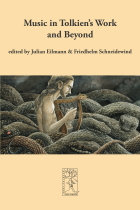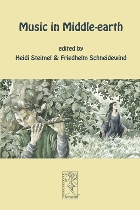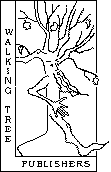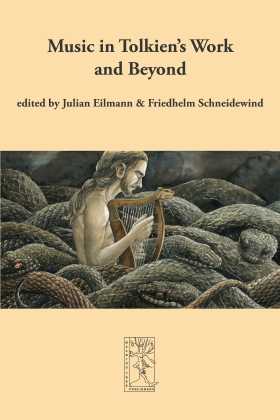Music in Tolkien's Work and Beyond
Julian Eilmann & Friedhelm Schneidewind (editors)
Cormarë Series No. 39

<--previous | all publications | next-->
how to buy this item
 "I love music" (J.R.R. Tolkien)
"I love music" (J.R.R. Tolkien)
Music plays a crucial role in Tolkien's mythology, and his tales contain
many songs as well as mentions of musicians and instruments.
The present book edited by Julian Eilmann and Friedhelm Schneidewind is the successor to the well-received 2010 volume Music in Middle-earth, No. 20 of the Cormarë Series, which drew the attention of Tolkien scholarship to the importance and nature of music in Tolkien's work. As the title of this volume suggests, Music in Tolkien's work and Beyond simultaneously follows the path of analyzing the use and significance of music and musical elements in Tolkien's literary texts while also considering the broader context, such as adaptations and other authors and composers.
The 21 articles feature a multitude of different academic approaches, e.g. musicological, philosophical or theological, which not only look at music itself but also at poetry, song and instruments and even the musicality of Tolkien’s prose. the contributions are divided into five sections: 'Tolkien and Music', 'The Power of Music', 'Music of Different Texts and Characters', 'Instruments in Middle-earth' und 'Music beyond Tolkien'.
table of contents | abstracts | cover | companion volume | german version | announcements | more

Table of contents
Julian Eilmann & Friedhelm Schneidewind
Introduction
"I love music": The Musicality of the Philologist
TOLKIEN AND MUSIC
Chiara Bertoglio
Polyphony, Collective Improvisation, and the Gift of Creation
(abstract)
Michaël Devaux & Guglielmo Spirito
Laments and Mercy:
Tolkien and Liturgical Music
(abstract)
Nancy Martsch
Middle-earth Improv:
Song Writing and Improvisation in Tolkien's Works
(abstract)
Łukasz Neubauer
"What news from the North?": The Compositional Fabric, Intricate
Imagery and Heroic Christian Character of the "Lament for Boromir"
(abstract)
Jörg Fündling
"Go forth, for it is there!"
An Imperialist Battle Cry behind the Lament for Boromir?
(abstract)
THE POWER OF MUSIC
Elizabeth A. Whittingham
"A Matter of Song":
The Power of Music and Song in Tolkien's Legendarium
(abstract)
Bradford Lee Eden
"The Scholar as Minstrel":
Word-music and Sound-words in Tolkien's "New Works"
(abstract)
Lynn Forest-Hill
Tolkien's Minstrelsy:
The Performance of History and Authority
(abstract)
Maureen F. Mann
Musicality in Tolkien's Prose
(abstract)
Petra Zimmermann
"A deep silence fell":
Silence and the Presentation of 'Voices' in Tolkien
(abstract)
MUSIC OF DIFFERENT TEXTS AND CHARACTERS
Renée Vink
Dance and Song: "The Lay of Leithian" between
"The Tale of Tinúviel" and "Of Beren and Lúthien"
(abstract)
Jennifer Rogers
Music and the Outcast:
Songs of the Wanderer in Tolkien's Time-Travel Fragments
(abstract)
Angela P. Nicholas
Aragorn, Music and the "Divine Plan"
(abstract)
Sabine Frambach
"Where you hear song, you may rest at ease":
The Music of the Evil Ones in Middle-earth
(abstract)
INSTRUMENTS IN MIDDLE-EARTH
Heidi Steimel
An Orchestra in Middle-earth
(abstract)
John Holmes
Nis me ti hearpun hygi:
Harping on One String in Middle-earth
(abstract)
Allan Turner
The Horns of Elfland
(abstract)
Rainer Groß
Portatives in Middle-earth:
A Speculative Approach to Organ Instruments in Tolkien’s Work
(abstract)
MUSIC BEYOND TOLKIEN
Anja Müller
The Lords of the Rings:
Wagner’s Ring and Tolkien’s "Faërie"
(abstract)
Patrick Schmitz
"True Music in the Words":
A Comparative Analysis of the Function of Music in Tolkien's
The Lord of the Rings and Rothfuss' Kingkiller Chronicles
(abstract)
Tobias Escher
Of Home Keys and Music Style Guides:
Orchestral Scores for Tolkien-based Video Games
(abstract)
table of contents | abstracts | cover | companion volume | german version | announcements | more

Abstracts
Introduction
"I love music": The Musicality of the Philologist
TOLKIEN AND MUSIC
Tolkien's creation myth, as transmitted in the Silmarillion and in other sources, describes the Ainur's singing as a form of collective polyphonic improvisation. This singing derives from the themes "declared" by Il&ucaute;vatar, which are – it will be argued – a form of divine self-revelation (and therefore of knowledge) imparted to the Ainur within the framework of a personal relationship with the God. The beauty of the Ainur's improvisation thus depends on their revealed knowledge of the creator's mind, on their loving attitude to Him and to their brethren, and on their acceptance of the rules and limitations of created beings as a gift which enables their singing to achieve its fulfillment and perfection. This approach, as will be discussed, is Tolkien's development of topics and imagery abundantly found in religious, literary, musical and mythological sources of the past.
Laments and Mercy:
Tolkien and Liturgical Music
The aim of this article is to offer an overview of Tolkien and the liturgical music of his time, with a focus on its possible influence on the Tolkienian conception of Elvish music. Guglielmo Spirito has reconstructed, focusing on the Kyrie eleison, the pieces of chant Tolkien used to hear at mass in Birmingham, Oxford and during his holidays in Assisi (1955). He also offers a spiritual appreciation of the themes of laments and Mercy from the Kyrie in Tolkien's texts. The larger content of what is sacred music and liturgical music from a canonical point of view at the beginning of the 20th Century is defined by Michaël Devaux, who also details the historical context of liturgical music in the Oratory of Birmingham and the history of the pieces of Gregorian chant Tolkien referred to in his texts or himself recorded.
Middle-earth Improv:
Song Writing and Improvisation in Tolkien's Works
The Hobbit and The Lord of the Rings contain many poems said to have been read, recited, chanted or sung by the participants in the stories. This essay will focus on the improvisation of songs and the writing of words to tunes: first treating these stories as authentic fictional history, translated by J.R.R. Tolkien, to observe how the characters created their songs; and then treating the stories as feigned history written by J.R.R. Tolkien, to examine how Tolkien created the songs himself. We will also examine previously created poems interpolated into The Lord of the Rings, and songs which Tolkien created (and sang) elsewhere.
In its classical sense, an elegy is a commemorative poem or song which deals with someone's – usually, the hero's – demise. It may therefore focus upon a vast array of themes connected with death and dying, such as remembering the one(s) who have died or comforting those who have lost their dear one(s). Very often they invoke the name of the deceased (as in Walt Whitman's "O Captain, My Captain!"), imaginatively summoning the one(s) who will, unfortunately, no longer be able to respond at the earthly stage of their existence. Finally, they may also lament the passing of an old way of life (as in the so-called ubi sunt poems), which may often be seen in the poetic works of Anglo-Saxon provenance. Frequently submerged in sorrow, various characters in the works of J.R.R. Tolkien are not in the least different from their literary models of the past. Their reasons may vary, of course, and so may the actual modes of their expression. Nevertheless, they all have at least a few noteworthy things in common – to express their undying love and honour those who have come to pass from Middle-earth. The following paper seeks to examine the often complex nature of elegiac verses in The Lord of the Rings with a particular emphasis upon their compositional and performative dimensions, symbolism, heroic resonances and Christian implications in the "Lament for Boromir", a moving farewell song performed by Aragorn and Legolas in the wake of their companion's impressive, if hastily organised, boat-burial in the mould of ancient funerary rites for the heroic fallen.
"Go forth, for it is there!"
An Imperialist Battle Cry behind the Lament for Boromir?
The first chapter of Book III of The Lord of the Rings includes a poem which, despite various similarities to songs and poems in that novel, surprises by its highly recursive and catalogue-like structure – even though this may almost seem a necessity, given that three of the winds that blow over Minas Tirith are questioned on the whereabouts of Boromir. But yet another reason consists in Tolkien's rather unlikely pattern for such a striking composition: in Rudyard Kipling's "The English Flag", first published 1891 as a call for toil and sacrifice in the service of the British Empire, lavishly equipped with evocative place names and the promise of mortal danger. By all probability Tolkien absorbed the technical brilliance and blatant patriotism of this pervasive piece of art in his early years. In the winter of 1941-2, when Britain's colonies in East Asia were falling to the Japanese in quick succession, he used the framework and, partly, the moods of the very first instance of Kipling's Imperialist verse for his own purpose. In Tolkien’s poem the winds convey a message of death, uncertainty, and sorrowful memories; the events of the day may well have left their marks during the process.
THE POWER OF MUSIC
"A Matter of Song": The Power of Music and Song in Tolkien's Legendarium
The Silmarillion uses music for some of the same purposes as The Hobbit and The Lord of the Rings, but the tales and histories of the legendarium go beyond the use of song in these works. The Silmarillion begins with the Great Music in the Ainulindalë through which the entire cosmos is created, and music's creative power is evident in other parts of the legendarium. Early in the Quenta Silmarillion, Fëanor suggests that being remembered in song will somehow justify what the Elves will suffer, a perspective that Manwë seems to corroborate. Song is even used in battle and as a means of leveling a fortress. These uses along with its creative ability are distinctly different from those in the popular works and indicate that music is the most powerful force in Tolkien's universe and essential to the beings of Middle-earth.
"The Scholar as Minstrel":
Word-music and Sound-words in Tolkien's "New Works"
This chapter builds upon previous papers and book chapters by the author related to Tolkien's use of musical allusion in his works, as well as his roots in language and sound that are now supported by a number of "new" works that have been published in recent years, specifically The Story of Kullervo, Beowulf: A Translation and Commentary, The Lay of Aotrou & Itroun, The Legend of Sigurd & Gudrúfn, The Fall of Arthur, and A Secret Vice. Tolkien's earliest experiments and writings in his mythology show an intense interest in the use and power of music as a creational and thematic expression. The publication of these "new" works provide further evidence that Tolkien definitively favored a strong relationship between music and language, specifically using terms like sound-words, word-music, sound symbolism, and sound aesthetics.
Tolkien's Minstrelsy:
The Performance of History and Authority
The Lord of the Rings reflects medieval minstrelsy primarily in the recollection of culturally significant history for the purposes of entertainment or solace. This paper considers the functions of the many instances of 'informal', or non-professional minstrelsy in the story. It highlights the essential importance of the informal oral dissemination of history in Middle-earth for racial and social integration. As historical recollection in The Lord of the Rings necessarily and predominantly references The Silmarillion, the paper argues that Tolkien historicises the relationship between oral and textual versification in ways that challenge notions of textual authority and status, and that he thereby claims the absolute authority of the creative process by smuggling into print versions of Silmarillion material which are the subjects of informal minstrelsy.
Using statements from A Secret Vice, the "Essay on Phonetic Symbolism", and Tolkien's Letters, this paper examines Tolkien's prose style in light of his own comments about the significance of phonetics and the role of sound in communicating meaning, as well as the role of mellifluous expressions to enhance or help formulate the comprehension of meaning. The methodology applies historical interrogation and textual analysis using traditional rhetorical devices from public speaking (such as anaphora, epistrophe, symploce, word schemes, and schemes of arrangement for grammar) to identify rhythmic emphasis and sound repetition which create musicality. It focusses almost exclusively on works published in Tolkien's lifetime with some comparison to The Book of Lost Tales. It also examines the various narrative situations which show musicality.
"A deep silence fell":
Silence and the Presentation of 'Voices' in Tolkien
In Tolkien's work, silence has a role in two contexts: on the one hand as silence experienced in nature in landscape descriptions, and on the other hand in the field of (musical) presentations of poems. For Tolkien silence (almost) always serves as a background for the sounding of multifarious 'voices' – either of voices from nature or of voices from the characters of the novels who recite a poem or sing a song. The following essay explores how these 'voices' are presented against the background of silence and how Tolkien achieves to hook the reader into the narrative world through the interaction of silence and voices.
MUSIC OF DIFFERENT TEXTS AND CHARACTERS
Dance and Song: "The Lay of Leithian" between "The Tale of Tinúviel" and "Of Beren and Lúthien"
Beren and Lúthien: from "ballet" to "opera". This is a tale rich with music and song, from Daeron's "“music from a pipe unseen" to Lúthien's song before the inexorable Mandos. However, though music was always present in this core story of The Silmarillion, it was not always the predominant art form. This paper shows how, over the years, Tolkien turned it from a story dominated by dance into one in which music and song gradually began to take over until only one dancing scene remained. But it was the most important one, and the most personal to Tolkien himself.
Music and the Outcast:
Songs of the Wanderer in Tolkien's Time-Travel Fragments
Tolkien's time-travel fragments, The Lost Road (LR) and The Notion Club Papers (NCP), contain a number of songs which seem disconnected from the two texts’ main narratives. However, an ethnomusicological review of these songs shows how the music in LR and NCP discuss some of the stories' central themes: mortality and belonging. By studying these songs and their singers in cultural context, it will be argued that Tolkien uses music to draw a clear picture of the singers' personal and communal identities as they explore ideas of mortality within the texts. The same ethnomusicological approach used to study the songs of LR and NCP will then be applied to current primary world songs in order to argue for the characteristic ability of music to discuss questions of mortality while defining the personal and communal identities inherent to those questions.
Aragorn, Music and the "Divine Plan"
The following paper examines the different aspects of music (vocal and instrumental) and verse in relation to the life and character of Aragorn, considering him as a musician and poet in his own right, as someone who understands and appreciates music and poetry, and as the subject of songs and verses. Particular attention is paid to his circumstances and emotions, thus gaining psychological insight into the nature of his struggles and hardship. Overall the discussion is set within the context of the significance of music in Aragorn's Maian/Elven ancestry and background, and in his role in Tolkien's legendarium.
"Where you hear song, you may rest at ease":
The Music of the Evil Ones in Middle-earth
This paper draws our attention to the dichotomy of evil characters in Middle-earth and music. While music and song are mostly associated with positive aspects like joy and artistry, Frambach explains what kind of instruments are preferred by evil beings and how creatures like orcs make use of music in their own wicked way.
INSTRUMENTS IN MIDDLE-EARTH
Tolkien's Middle-earth has inspired many musicians to compositions, both
vocal and instrumental. This paper introduces readers to the following classical
orchestral works:
The Hobbit by Carey Blyton
Symphony Nr. 1, "The Lord of the Rings" by Johan de Meij
The Dreams of Gandalf by Aulis Sallinen
Middle Earth by Craig H. Russell
Quendi, Valaquenta I, Eldarinwe Lirí, Eärendil, the Mariner, and Telperion and
Laurelin, all by Martin Romberg
Heidi Steimel examines the effect orchestral music has in evoking emotions
and bringing its listeners into Middle-earth. After all, these compositions come
from outside the secondary world and do not intend to sound as if they were
authentically played within the context of the story. They are therefore different
from music composed for Tolkien's poems and add variety to the mix of
folk music, heavy metal, and film soundtracks which are popularly heard by
Middle-earth fans. Music that has been composed for concert audiences may
even help raise awareness of the depth of Tolkien’s literary legacy and attract
new readers.
Nis me ti hearpun hygi:
Harping on One String in Middle-earth
The harp is a metonym for poetry in many cultures, and Tolkien's Middle-earth is no exception. But an inventory of references to harps throughout Tolkien's works reveals a preponderance of elegiac sentiment connected with the harp. In a passage from the Old English Seafarer, recollected in a dream by a character in Tolkien's Notion Club papers (nis me ti hearpun hygi, "for no harp have I heart"), the harp in the poem becomes an emblem of ancient music, and ancient language itself, calling to the modern mind in an inexplicable way. That ancient music provides the "Door to Other Time" Tolkien found in Fairy Story – as does language itself. A study of an Old English translation of Psalm 137 ("By the Waters of Babylon") suggests that the harp already had such associations in Judeo-Christian tradition. Tolkien's philological comments on the word "harp" in an (undated) lecture to the Lincoln Musical Society illuminate the role of the harp image in Tolkien's creative imagination.
Perhaps the most iconic line of English poetry to evoke the world of the imagination just on the edge of consciousness is "The horns of Elfland faintly blowing" from "The Princess" by Tennyson. Music as a liminal area between the real and the imagined is a topos that figures in other works of fantasy, such as Lord Dunsany's The King of Elfland's Daughter, which refers back directly to Tennyson. In Tolkien the Elves in particular are associated with songs that operate more on the unconscious mind than the conscious. However, the essay that Tolkien wrote on his own Smith of Wootton Major, which has been little regarded by criticism so far, gives the alert reader a clue that access to the world of Faerie depends on the willingness of mortals to make music of their own that can resonate in harmony with the immortal tones. Echoes of this can be found in The Lord of the Rings, most obviously in the last chapter, where Frodo's variation on the walking song that sees him moving beyond the everyday paths into the unknown is immediately taken up by the Elves in their more elevated hymn to Elbereth. This echoes an idea found in medieval and renaissance Christian thought, that earthly music forms a link to the harmony of heaven, as formulated by Milton in his poem "At a Solemn Music".
Portatives in Middle-earth:
A Speculative Approach to Organ Instruments in Tolkien’s Work
The following article is a speculative study on organ building in Middle-earth, which – although there is no explicit mention of it – could have taken place there. A specific kind of small organ, so called 'portative organ' or 'organetto', is described in different examples by its medieval design and its possible appearance in Middle-earth.
MUSIC BEYOND TOLKIEN
The Lords of the Rings:
Wagner’s Ring and Tolkien’s "Faërie"
This essay attempts to assess correspondences between Richard Wagner's Der Ring des Nibelungen and J.R.R. Tolkien's The Lord of the Rings with respect to contents and conceptualization. A first part examines the analogies and differences that can be traced between the two eponymous rings of power in the tetralogy and the trilogy. A second section reads Wagner's Oper und Drama together with Tolkien's "On Fairy-Stories", exploring the question in how far Wagner's idea of a music drama as Gesamtkunstwerk actually approaches the genre of "fantasy drama" which Tolkien believed to be impossible. Employing an intertextual approach, the discussion seeks to eschew speculations concerning possible motivations for the investigated rela-tionships and refrains from evaluating one of the two works over the other.
This essay analyses different facets of music in Tolkien's The Lord of the Rings and Rothfuss' The Kingkiller Chronicles. In particular, it examines which function and effect the inclusion of music, music-related imagery and connected phenomena fulfils within the works of both authors. In doing so, similarities and differences between Tolkien's seminal work and the ground-breaking piece of new fantasy literature shall be revealed.
Of Home Keys and Music Style Guides:
Orchestral Scores for Tolkien-based Video Games
One medium for literary adaptations often overlooked are video games. Having
been graced with large orchestral scores for quite some time now, a large number
of Tolkien-based video games extend the Legendarium into a new medium
presumably undreamt of by Tolkien himself. Individual composers created
coherent scores for these productions, uniquely in the industry tied together
by a stylistic unity and the supervision of a head composer. This paper will
reveal and discuss musical elements used and compare and contrast them to
Tolkien’s own writings about music and related subjects.
Composer Chance Thomas has been responsible for a large number of video
games in Vivendi/Universal'’s Tolkien-based franchises. Unique for a video
game franchise, Thomas as a Music Director created what he calls a "Tolkien
Music Style Guide" with information about the musical characteristics of
various cultures in the narrative. He also composed themes for various races
and locations, which would later be used by him and other composers in their
scores for video games. This thematic unity between otherwise unrelated games
produced (and scored) by different people is very unique in the video game
industry and allows for a detailed analysis of how an interactive medium adapts
descriptions intended for written medium. Thus Tolkien-based games, thanks
to the extremely large universe behind the actual narrative, allow for a broad
insight into world-building, taking into account Tolkien’s views on sub-creation.
table of contents | abstracts | cover | companion volume | german version | announcements | more

Cover
Cover illustration 'Gunnar in the Snakepit' by Anke Eissmann
table of contents | abstracts | cover | companion volume | german version | announcements | more

Companion volume
 This volume has a companion volume, Music in Middle-earth, Cormarë Series No. 20, Walking Tree Publishers 2010, ISBN: 978-3-905703-14-6.
This volume has a companion volume, Music in Middle-earth, Cormarë Series No. 20, Walking Tree Publishers 2010, ISBN: 978-3-905703-14-6.
table of contents | abstracts | cover | companion volume | german version | announcements | more

A German version of Music in Tolkien's Work and Beyond is published in parallel by Edition Stein und Baum under the title Musik in Tolkiens Werk und darüber hinaus, ISBN ???. (further information forthcoming)
table of contents | abstracts | cover | companion volume | german version | announcements | more

Announcements
Eight book reviews (4th July 2023)
Book reviews in Fafnir (6th April 2023)
Two reviews of Music in Tolkien's Work and Beyond (20th January 2021)
Many reviews (17th July 2020)
New publication, Music in Tolkien's Work and Beyond (7th October 2019)
Call for Papers, Music and Middle-earth (24th August 2016)

474 pages, Walking Tree Publishers 2019, Cormarë Series No. 39, Editor: Julian Eilmann
& Friedhelm Schneidewind
, ISBN: 978-3-905703-39-9.

<--previous | all publications | next-->
how to buy this item

More on Music in Tolkien's Work and Beyond

terms and conditions
visitors since 06.08.19
last updated 16.09.19

